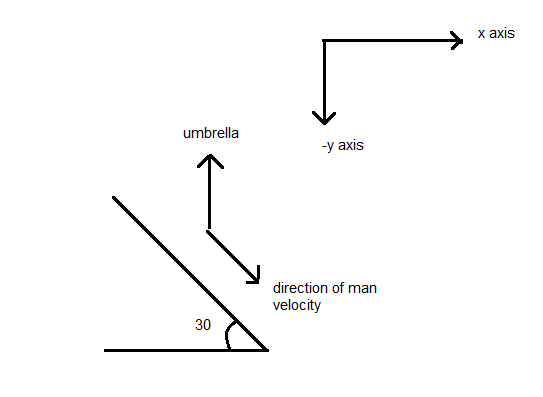
A man is coming down an incline of angle \[{{30}^{0}}\], When he walks with speed \[2\sqrt{3}\]m/s he has to keep his umbrella vertical to protect himself from rain. The actual speed of rain is 5m/s. At what angle with vertical should he keep his umbrella when he is at rest so that he does not get drenched?
Answer
559.8k+ views
Hint: In this problem we have to use vector algebra in order to find out the desired angle. The rain is falling vertically downwards and the man is walking on an inclined plane at an angle of \[{{30}^{0}}\]. The velocity vector of the man and the velocity vector of the rain can be added vectorially in order to find the resultant vector.
Complete step by step answer:
We find the velocity of rain with respect to rain.

Since the angle between the velocity vector and the rain is not perpendicular, hence, the umbrella should be held tilted at some angle with respect to vertical.
Horizontal component of velocity vector,
$
v\cos 30=\dfrac{\sqrt{3}}{2}\times 2\sqrt{3} \\
\Rightarrow 3m{{s}^{-1}} \\
$
And the vertical component is \[v\sin 30=\dfrac{1}{2}\times 2\sqrt{3}=\sqrt{3}m{{s}^{-1}}\]
Let the angle that umbrella made with the vertical be \[\alpha \]
Velocity of rain with respect to the man can be given as: \[{{\overrightarrow{v}}_{RM}}={{\overrightarrow{v}}_{R}}-{{\overrightarrow{v}}_{M}}\]
\[\Rightarrow 5\{\sin \alpha \widehat{i}+\cos \alpha \widehat{j\}}-(3\widehat{i}-\sqrt{3}\widehat{j})\]
$
\Rightarrow 5\sin \alpha -3=0 \\
\Rightarrow \alpha ={{\sin }^{-1}}(\dfrac{3}{5}) \\
\therefore \alpha ={{37}^{0}} \\
$
so when man is at rest then he must have to hold his umbrella at 37 degree with the vertical
Note:
We have resolved the vector in order to find the resultant direction. Here we have put the vertical component equal to zero because the umbrella is making angle with the vertical and not with the horizontal, thus we put the horizontal component of the resultant velocity equivalent to 0.
Complete step by step answer:
We find the velocity of rain with respect to rain.

Since the angle between the velocity vector and the rain is not perpendicular, hence, the umbrella should be held tilted at some angle with respect to vertical.
Horizontal component of velocity vector,
$
v\cos 30=\dfrac{\sqrt{3}}{2}\times 2\sqrt{3} \\
\Rightarrow 3m{{s}^{-1}} \\
$
And the vertical component is \[v\sin 30=\dfrac{1}{2}\times 2\sqrt{3}=\sqrt{3}m{{s}^{-1}}\]
Let the angle that umbrella made with the vertical be \[\alpha \]
Velocity of rain with respect to the man can be given as: \[{{\overrightarrow{v}}_{RM}}={{\overrightarrow{v}}_{R}}-{{\overrightarrow{v}}_{M}}\]
\[\Rightarrow 5\{\sin \alpha \widehat{i}+\cos \alpha \widehat{j\}}-(3\widehat{i}-\sqrt{3}\widehat{j})\]
$
\Rightarrow 5\sin \alpha -3=0 \\
\Rightarrow \alpha ={{\sin }^{-1}}(\dfrac{3}{5}) \\
\therefore \alpha ={{37}^{0}} \\
$
so when man is at rest then he must have to hold his umbrella at 37 degree with the vertical
Note:
We have resolved the vector in order to find the resultant direction. Here we have put the vertical component equal to zero because the umbrella is making angle with the vertical and not with the horizontal, thus we put the horizontal component of the resultant velocity equivalent to 0.
Recently Updated Pages
Why are manures considered better than fertilizers class 11 biology CBSE

Find the coordinates of the midpoint of the line segment class 11 maths CBSE

Distinguish between static friction limiting friction class 11 physics CBSE

The Chairman of the constituent Assembly was A Jawaharlal class 11 social science CBSE

The first National Commission on Labour NCL submitted class 11 social science CBSE

Number of all subshell of n + l 7 is A 4 B 5 C 6 D class 11 chemistry CBSE

Trending doubts
10 examples of friction in our daily life

One Metric ton is equal to kg A 10000 B 1000 C 100 class 11 physics CBSE

Difference Between Prokaryotic Cells and Eukaryotic Cells

1 Quintal is equal to a 110 kg b 10 kg c 100kg d 1000 class 11 physics CBSE

State the laws of reflection of light

Explain zero factorial class 11 maths CBSE




